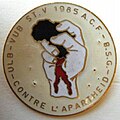| Saint Verhaegen | |
|---|---|
 Saint Verhaegen festivities in Brussels | |
| Nickname | St V |
| Status | Active |
| Date | 20 November |
| Frequency | Annual |
| Venue |
|
| Locations | City of Brussels, Brussels-Capital Region |
| Coordinates | 50°50′27″N4°21′18″E / 50.84085°N 4.35505°E |
| Country | Belgium |
| Inaugurated | 24 November 1888 |
| Founder | Free University of Brussels |
| Most recent | 20 November 2025 |
| Next event | 20 November 2026 |
Saint Verhaegen (French : Saint-Verhaegen; Dutch : Sint-Verhaegen), commonly shortened to Saint-V (in French), Sint-V (in Dutch), or St V, is an annual student celebration held on 20 November in Brussels, Belgium, to mark the founding of the Free University of Brussels in 1834. The name is a reference to Pierre-Théodore Verhaegen, the university's founder, who ironically is not a saint and promoted free inquiry ; it was chosen in parody of Saint Nicholas festivities at the rival Catholic University, reflecting the event's freethinking and humanist spirit. [1]
Contents
- History
- Origins of Saint Verhaegen
- Evolution of the event
- Wartime celebrations
- Post-WWII
- 21st century
- Celebrations
- Yearly themes and medals
- Overview of the annual themes since 1931
- See also
- References
- External links
First held in 1888 as a protest against the then-academic authorities, Saint Verhaegen has grown into a central element of Brussels' student folklore, combining an official commemoration and a large parade through the city. Organised by the French- and Dutch-speaking Brussels Student Associations, it brings together students, alumni, staff and professors from the Université libre de Bruxelles (ULB) and the Vrije Universiteit Brussel (VUB). A festive tribute to freedom of thought and expression and a platform for social critique, [1] the festivities also include side activities organised by student societies and attract thousands of participants.
Since 1931, a different theme (illustrated with a medal) has been chosen for each edition, usually responding to current events and taking a liberal/anti-clerical approach. Since 2019, Saint Verhaegen has also been listed as intangible cultural heritage of the Brussels-Capital Region. [2]


















